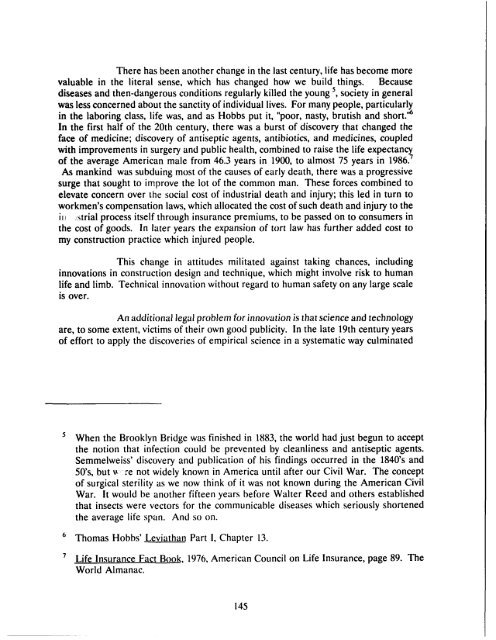Challenges and Opportunities for Innovation in the Public Works ...
Challenges and Opportunities for Innovation in the Public Works ...
Challenges and Opportunities for Innovation in the Public Works ...
You also want an ePaper? Increase the reach of your titles
YUMPU automatically turns print PDFs into web optimized ePapers that Google loves.
There has been ano<strong>the</strong>r change <strong>in</strong> <strong>the</strong> last century, life has become more<br />
valuable <strong>in</strong> <strong>the</strong> literal sense, which has changed how we build th<strong>in</strong>gs. Because<br />
diseases <strong>and</strong> <strong>the</strong>n-dangerous conditions regularly killed <strong>the</strong> young 5, society <strong>in</strong> general<br />
was less concerned about <strong>the</strong> sanctity of <strong>in</strong>dividual lives. For many people, particularly<br />
<strong>in</strong> <strong>the</strong> labor<strong>in</strong>g class, life was, <strong>and</strong> as Hobbs put it, "poor, nasty, brutish <strong>and</strong> short." 6<br />
In <strong>the</strong> first half of <strong>the</strong> 20th century, <strong>the</strong>re was a burst of discovery that changed <strong>the</strong><br />
face of medic<strong>in</strong>e; discovery of antiseptic agents, antibiotics, <strong>and</strong> medic<strong>in</strong>es, coupled<br />
with improvements <strong>in</strong> surgery <strong>and</strong> public health, comb<strong>in</strong>ed to raise <strong>the</strong> life expectancy<br />
of <strong>the</strong> average American male from 46.3 years <strong>in</strong> 1900, to almost 75 years <strong>in</strong> 1986.7<br />
As mank<strong>in</strong>d was subdu<strong>in</strong>g most of <strong>the</strong> causes of early death, <strong>the</strong>re was a progressive<br />
surge that sought to improve <strong>the</strong> lot of <strong>the</strong> common man. These <strong>for</strong>ces comb<strong>in</strong>ed to<br />
elevate concern over <strong>the</strong> social cost of <strong>in</strong>dustrial death <strong>and</strong> <strong>in</strong>jury; this led <strong>in</strong> turn to<br />
workmen's compensation laws, which allocated <strong>the</strong> cost of such death <strong>and</strong> <strong>in</strong>jury to <strong>the</strong><br />
iiý istrial process itself through <strong>in</strong>surance premiums, to be passed on to consumers <strong>in</strong><br />
<strong>the</strong> cost of goods. In later years <strong>the</strong> expansion of tort law has fur<strong>the</strong>r added cost to<br />
my construction practice which <strong>in</strong>jured people.<br />
This change <strong>in</strong> attitudes militated aga<strong>in</strong>st tak<strong>in</strong>g chances, <strong>in</strong>clud<strong>in</strong>g<br />
<strong>in</strong>novations <strong>in</strong> construction design <strong>and</strong> technique, which might <strong>in</strong>volve risk to human<br />
life <strong>and</strong> limb. Technical <strong>in</strong>novation without regard to human safety on any large scale<br />
is over.<br />
An additional legal problem <strong>for</strong> <strong>in</strong>novation is that science <strong>and</strong> technology<br />
are, to some extent, victims of <strong>the</strong>ir own good publicity. In <strong>the</strong> late 19th century years<br />
of ef<strong>for</strong>t to apply <strong>the</strong> discoveries of empirical science <strong>in</strong> a systematic way culm<strong>in</strong>ated<br />
5 When <strong>the</strong> Brooklyn Bridge was f<strong>in</strong>ished <strong>in</strong> 1883, <strong>the</strong> world had just begun to accept<br />
<strong>the</strong> notion that <strong>in</strong>fection could be prevented by cleanl<strong>in</strong>ess <strong>and</strong> antiseptic agents.<br />
Semmelweiss' discovery <strong>and</strong> publication of his f<strong>in</strong>d<strong>in</strong>gs occurred <strong>in</strong> <strong>the</strong> 1840's <strong>and</strong><br />
50's, but wx re not widely known <strong>in</strong> America until after our Civil War. The concept<br />
of surgical sterility as we now th<strong>in</strong>k of it was not known dur<strong>in</strong>g <strong>the</strong> American Civil<br />
War. It would be ano<strong>the</strong>r fifteen years be<strong>for</strong>e Walter Reed <strong>and</strong> o<strong>the</strong>rs established<br />
that <strong>in</strong>sects were vectors <strong>for</strong> <strong>the</strong> communicable diseases which seriously shortened<br />
<strong>the</strong> average life span. And so on.<br />
6 Thomas Hobbs' Leviathan Part 1, Chapter 13.<br />
7 Life Insurance Fact Book, 1976, American Council on Life Insurance, page 89. The<br />
World Almanac.<br />
145







